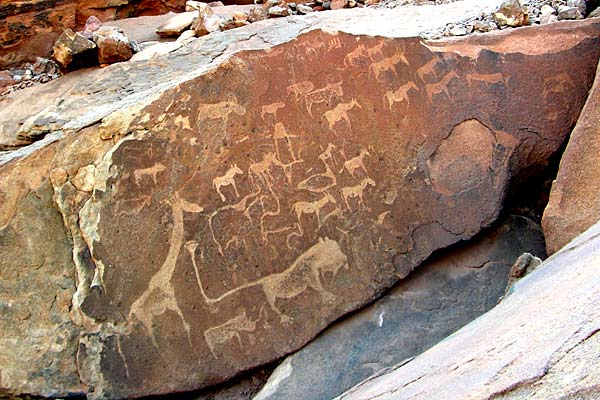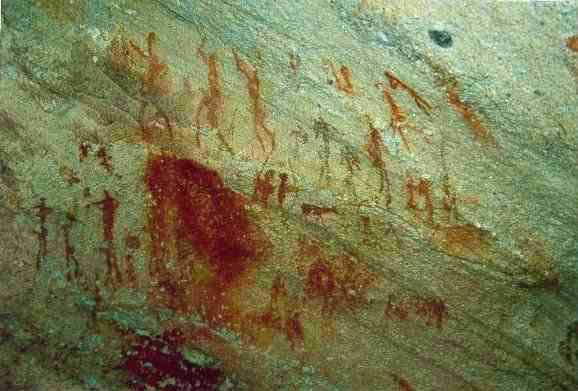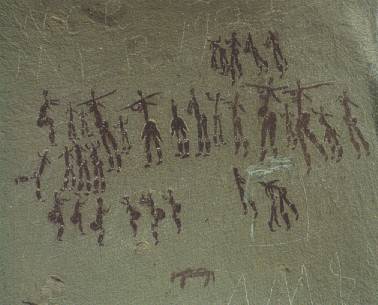SAN
- San rock art dates back as far as 27 000
 years ago. Both painting and engravings are found in South Africa, the former mainly in the more mountainous
areas, engravings mostly on the central plateau.
years ago. Both painting and engravings are found in South Africa, the former mainly in the more mountainous
areas, engravings mostly on the central plateau.
- The engravings depict mainly animals and geometric figures.
- The paintings depict humans involved in various activities. They were
all executed by shamans and reflected their memories of the trances and
hallucinations they underwent in order to connect their communities with the
natural and supernatural
 universe. Maybe they had a more complicated vision of
universe than people at such an early stages of human kind 's intellectual
and spiritual development. These paintings presented many events of the
universe. Maybe they had a more complicated vision of
universe than people at such an early stages of human kind 's intellectual
and spiritual development. These paintings presented many events of the
 San history: the San, living in small groups which came together in time of need,
were hunter-gatherers. They did not have chiefs: the shamans were the main
authority in San society but without political power. Because of
climate conditions rainmaking cerimonies were the subject of many paintings,
associated with the most common motif of the hunting of animal, particularly
eland.
San history: the San, living in small groups which came together in time of need,
were hunter-gatherers. They did not have chiefs: the shamans were the main
authority in San society but without political power. Because of
climate conditions rainmaking cerimonies were the subject of many paintings,
associated with the most common motif of the hunting of animal, particularly
eland. 
- San art may have been symbolic but it was also realistic. For
istance the scenes of war showed the dreadfull fact of the San's inability
to stem the tide of the advancing Bantu. Many paintings depicted the San
defeated from bigger and darker attackers armed with spears and shields, the
San themselves having only bows and arrows.
- Some time after 500 BCE (before common era) the practice of sheep herding
emerged in southern Africa. This new economy, based on breeding sheep and
later cattle, is associated with the spread of Khoi languages.
- In the eastern part of the country the San were later absorbed by Bantu
 speakers. Coexsistence with the Bantu resulted in the prominence of the click
sounds characteristic of Khoisan languages in the major contemporary South
African Bantu languages, Xhosa and Zulu. Similarly, many of these languages
use the Khoi vocabulary for all cattle-based pursuits.
speakers. Coexsistence with the Bantu resulted in the prominence of the click
sounds characteristic of Khoisan languages in the major contemporary South
African Bantu languages, Xhosa and Zulu. Similarly, many of these languages
use the Khoi vocabulary for all cattle-based pursuits.
Oggi i San, ritiratisi progressivamente nelle steppe del Kalahari, conducono
un' esistenza stentata. 2000 anni fa erano forse un milione oggi sono circa 50
000.
 years ago. Both painting and engravings are found in South Africa, the former mainly in the more mountainous
areas, engravings mostly on the central plateau.
years ago. Both painting and engravings are found in South Africa, the former mainly in the more mountainous
areas, engravings mostly on the central plateau.
 universe. Maybe they had a more complicated vision of
universe than people at such an early stages of human kind 's intellectual
and spiritual development. These paintings presented many events of the
universe. Maybe they had a more complicated vision of
universe than people at such an early stages of human kind 's intellectual
and spiritual development. These paintings presented many events of the
 San history: the San, living in small groups which came together in time of need,
were hunter-gatherers. They did not have chiefs: the shamans were the main
authority in San society but without political power. Because of
climate conditions rainmaking cerimonies were the subject of many paintings,
associated with the most common motif of the hunting of animal, particularly
eland.
San history: the San, living in small groups which came together in time of need,
were hunter-gatherers. They did not have chiefs: the shamans were the main
authority in San society but without political power. Because of
climate conditions rainmaking cerimonies were the subject of many paintings,
associated with the most common motif of the hunting of animal, particularly
eland. 
 speakers. Coexsistence with the Bantu resulted in the prominence of the click
sounds characteristic of Khoisan languages in the major contemporary South
African Bantu languages, Xhosa and Zulu. Similarly, many of these languages
use the Khoi vocabulary for all cattle-based pursuits.
speakers. Coexsistence with the Bantu resulted in the prominence of the click
sounds characteristic of Khoisan languages in the major contemporary South
African Bantu languages, Xhosa and Zulu. Similarly, many of these languages
use the Khoi vocabulary for all cattle-based pursuits.